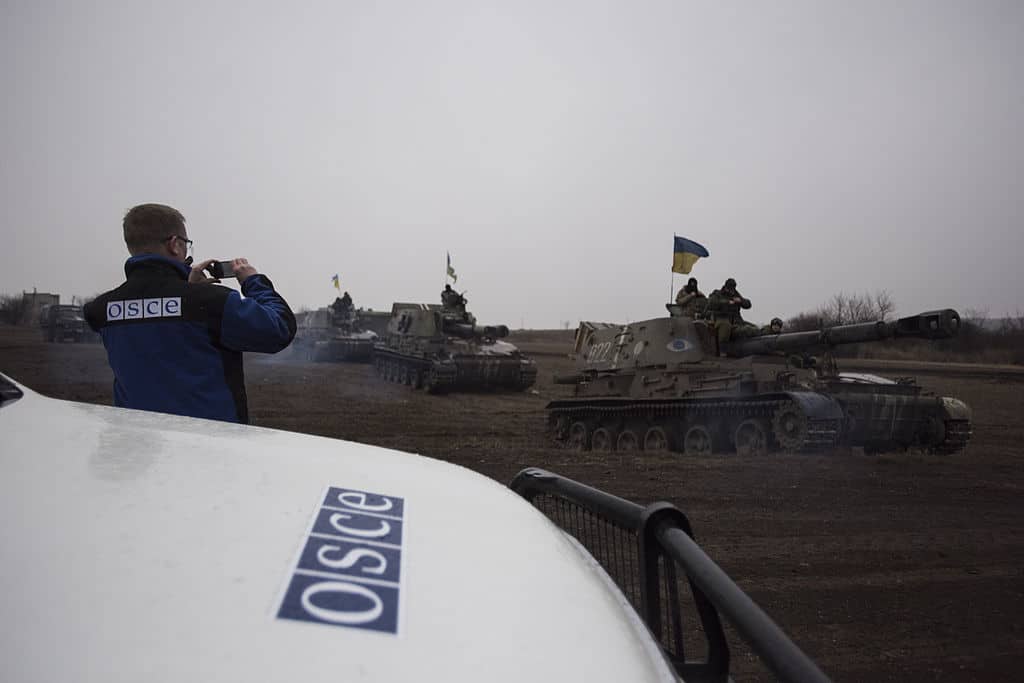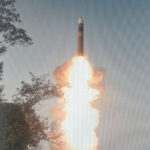How Russia’s retreat from the Vienna Document information exchange undermines European security
By Gabriela Iveliz Rosa-Hernández | March 24, 2023

Russia’s full-scale invasion of Ukraine has inflicted much suffering, amplified international divisions, and made any attempt to build common security extremely difficult. Moscow’s war on Ukraine also hobbled several arms control and security agreements—including, now, the Vienna Document.
Hosted by the Organization for Security and Co-operation in Europe (OSCE), the Vienna Document is a confidence- and security-building mechanism that allows participants to observe and notify each other about their military exercises and other relevant activities to prevent misinterpretation of each other’s military movements. The Vienna Document’s application zone spans the whole of Europe as well as the adjoining sea area and airspace. Participants must also share information about their armed forces and their defense budgets through the OSCE communications network, which is used by all participating countries to receive notifications.
The Vienna Document was founded in 1990 and is often seen as parallel to the Conventional Forces in Europe Treaty and the Open Skies Treaty in regard to establishing an “overarching” architecture of conventional arms control. The document was eventually adopted by the 57 OSCE participating countries as a politically binding agreement.
Despite its diminishing value after Russia suspended visits to verify the data exchange in early January 2022, the Vienna Document is arguably one of the few conventional risk-reduction tools that had resisted the tumultuous changes in the European security environment. Until it did not.
Russia stops cooperating. On March 6 of this year, Russia confirmed that it was no longer providing national information about its armed forces for 2023 as required by Chapter 1 of the Vienna Document 2011. The Russian delegation reportedly asserted that it would not be renouncing its obligation under the Vienna Document but would proceed depending on the actions of other participating countries. The Russian delegation previously accused 29 participating countries—including the United States and Ukraine—of not providing certain notifications of their military exercises on time.
Russia’s decision to cloak its military activities likely signals a return to strategic ambiguity. But, most important, the move may also signal Russia’s insecurity about its own conventional capacity to deter others’ potential military actions: Moscow has announced force posture changes to its Western military district, although a lot of the ins and outs of how Russia will achieve the goals of its defense priorities remain unclear.
Insecurity about its conventional forces is certainly not the only motivator in Moscow’s decision to not comply with its obligations under the Vienna Document. It is also not an isolated phenomenon in the deterioration of the existing arms control architecture. Essentially, Russia is cementing itself as a country in a state of war. “The West is using Ukraine as a battering ram against Russia and as a testing range,” Russian President Vladimir Putin said on February 21, 2023. With rhetoric like this, a functional Vienna Document is difficult to conceive.
The Vienna Document. NATO members have long argued that Russia’s approach to exercise notification under the terms of the Vienna Document inspires little confidence. Specifically, NATO members pointed to how Russia frequently broke down its large military exercises into smaller components, and classed them as a mix of regular and snap exercises, each of which falls under the document’s 13,000-troop limit. NATO members saw this as Moscow circumventing the agreement to hold, in fact, very large, unobserved exercises. But Russia insisted that the “snap exercises” were surprise tests of military readiness for their participants and notifying other countries would undermine their value. This back and forth marked a reciprocal dynamic in which Moscow obfuscated its activities allegedly for its own deterrence needs, and members of NATO were forced to rely on Moscow’s reputation that spoke for itself.
The Vienna Document has been updated several times, but not since 2011. This is in large part because Russia conditioned attempts to update the Vienna Document after 2014 on changes in NATO behavior, specifically an end to force buildups and “containment policy against Russia.” NATO members, or their part, accused Russia of noncompliance with the agreement and of exploiting its loopholes. The Vienna Document requires notification only of individual activities, land forces “independently or in combination with any possible air or naval components,” and only under a single operational command. Many Russian military exercises, therefore, occurred without prior notification.
Other major US concerns about Russia’s adherence to the Vienna Document include its failure to provide information about its forces and equipment in the Russian-occupied territories of Abkhazia, South Ossetia, and Crimea, among others.
Moscow also seems to continue to hold its own grievances with the agreement: “For example, on February 16, the largest multinational Orion-23 exercises in recent decades started in France. We learned about their beginning from the press, and not through the official channels of the Vienna Document. This is even though NATO allies are practicing large-scale military operations in all environments during these maneuvers,” the head of the Russian delegation in Vienna Konstantin Gavrilov said on March 6, 2023. Gavrilov also noted that Western countries have not agreed on the dates for the annual meeting to assess the implementation of the Vienna Document.
Even though the Vienna Document did little by design to reverse or prevent Russia’s invasion of Ukraine, it made it easier for NATO countries and Ukraine, among others, to publicly call out Russia’s build-up and its intentions. The instrument also allowed OSCE participating countries to document their suspicions over Russia’s actions twice in the past.
In the Spring of 2021, Ukraine triggered Vienna Document’s risk reduction consultations and requested that Russia clarify its military activities and build-up of its forces near Ukraine. Russia refused to respond to the inquiry and insisted that it had no obligation to do so but accepted a Swiss inspection in the territories of Voronezh and Belgorod—two regions near Ukraine’s eastern border.
However, in January 2022—on the eve of Russia’s invasion of Ukraine—Belarus and Russia announced their joint Allied Resolve military exercise. Latvia requested an inspection under the Vienna Document to ascertain the scope of Russia’s military activities and determine if Russia needed to report its activities. Russia rejected the inspection. “The formal reason for declining inspection was difficult situation with Covid-19, but that has not prevented Russia from putting massive enlisting and military manoeuvre plan in motion at the same time,” the Statement by the Latvian Ministry of Defense reads. Russia then announced that it would no longer host on-site inspection and evaluation visits likely in an attempt to conceal its war plans from the OSCE citing the COVID-19 pandemic.
The notions of visits and information exchange under the auspices of the Vienna Document became difficult to fathom as Russia waged its brutal war on Ukraine. After one year of the war, Russia reiterated that it would not comply with the Vienna Document’s annual information exchange and that it had no intention of doing so for the rest of the year.
Is the Vienna Document dead? The Vienna Document served as a working risk-reduction consultation mechanism not only between Russia and NATO members but also between Ukraine, Georgia, Moldova, and other countries that participate in the OSCE. By refusing to provide information about its forces, Russia has put the burden on other OSCE participating countries as to whether they want to maintain the Vienna Document. While Moscow leaves open the option for it to return to the agreement in the future, Russia’s decision puts the future of the entire OSCE in question. If Moscow were to solely jettison the agreement its ally, Belarus, could relay the information to Russia after it announced that it would resume verifications under the Vienna Document in mid 2022. This kind of behavior would put more pressure on Western countries to drop out of the agreement altogether.
Throughout 2022, Moscow expressed mixed feelings about the future of the Vienna Document. In August, Russia’s Minister of Defense Sergey Shoigu stated that “the Vienna Document 2011 remains formally in force, but there are no prospects for its practical implementation. In the absence of trust between the parties, the verification mechanism actually becomes a source of intelligence information, which does not meet the spirit of the agreement.”
The United States and other Western countries shared information about their armed forces with the OSCE for the 2023 year. In coming years, Western countries—including Ukraine—may choose to continue providing information about their armed forces during the annual information exchange, as they are now doing. This would continue to give Russia access to the information. But Western countries may opt to not provide the information or even pull out of the agreement if Moscow continues its noncompliance with its obligations.
The future of risk reduction tools. The future of confidence and security-building mechanisms with Russia looks grim. When asked by a journalist at a Valdai Club Event about what possible proposals might Russia have for de-escalation in the Baltic Sea region, Alexander Grushko, Russia’s ex-representative to the NATO-Russia Council and Deputy Minister of Foreign Affairs, declared that the security situation in the Euro-Atlantic region must return to how it was in 1997, highlighting that NATO members must commit to reverse all military deployments on the territory of states that were not alliance members in May 1997 as Russia proposed in 2021.
Moscow’s decision to not comply with its obligations under the Vienna Document is part of its overall disengagement with the post-Cold War arms control architecture. As with Russia’s decision to not comply with New START, Western countries will be forced to invest more in intelligence gathering. While Russian leadership may see secrecy as an ideal tool to cloak possible weakness, Moscow’s decision also contributes to a heightened risk of misperception of its own military activities. A world without the Vienna Document—or similar mechanisms—is one with more bluster and coercive threats, and perhaps, even further aggression. Such a world would set the stage for more crises, including the risk of nuclear escalation. It is up to policymakers, experts, and the public alike to reimagine risk-reduction tools—if the security architecture in the Euro-Atlantic region stabilizes.
Together, we make the world safer.
The Bulletin elevates expert voices above the noise. But as an independent nonprofit organization, our operations depend on the support of readers like you. Help us continue to deliver quality journalism that holds leaders accountable. Your support of our work at any level is important. In return, we promise our coverage will be understandable, influential, vigilant, solution-oriented, and fair-minded. Together we can make a difference.















